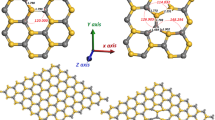Abstract
A method for uniquely determining the densities and energy levels of impurities from the temperature dependence of the majority-carrier concentration in wide band gap semiconductors (e.g., SiC, GaN, and diamond) is discussed. It is demonstrated that the proposed graphical peak analysis method can evaluate the number of impurity species and can determine those densities and energy levels uniquely and accurately, while fitting a simulation to the experimental temperature-dependent majority-carrier concentration leads to less reliable densities and energy levels of impurities. In the case that the Fermi levels in p-type SiC, GaN and diamond are located between the acceptor level and the valence band maximum, the excited states of acceptors strongly affect the hole concentration. This indicates the distribution function including the influence of the excited states should be applied to determine the densities and energy levels of acceptors from the temperature-dependent hole concentration.









Similar content being viewed by others
References
H. Matsuura, K. Sonoi, Jpn. J. Appl. Phys. 35, L555 (1996)
S. Kagamihara, H. Matsuura, T. Hatakeyama, T. Watanabe, M. Kushibe, T. Shinohe, K. Arai, J. Appl. Phys. 96, 5601 (2004)
H. Matsuura, M. Komeda, S. Kagamihara, H. Iwata, R. Ishihara, T. Hatakeyama, T. Watanabe, K. Kojima, T. Shinohe, K. Arai, J. Appl. Phys. 96, 2708 (2004)
H. Matsuura, J. Appl. Phys. 95, 4213 (2004)
H. Matsuura, T. Morizono, Y. Inoue, S. Kagamihara, A. Namba, T. Imai, T. Takebe, Jpn. J. Appl. Phys. 45, 6376 (2006)
H. Matsuura, Phys. Rev. B 74, 245216 (2006)
H. Matsuura, Masuda, Y. Chen, S. Nishino, Jpn. J. Appl. Phys. 39, 5069 (2000)
H. Matsuura, H. Nagasawa, K. Yagi, T. Kawahara, J. Appl. Phys. 96, 7346 (2004)
H. Matsuura, D. Katsuya, T. Ishida, S. Kagamihara, K. Aso, H. Iwata, T. Aki, S.-W. Kim, T. Shibata, T. Suzuki, Phys. Status Solidi C 0, 2214 (2003)
M. Ikeda, H. Matsunami, T. Tanaka, Phys. Rev. B 22, 2842 (1980)
W. Götz, A. Schöner, G. Pensl, W. Suttrop, W.J. Choyke, R. Stein, S. Leibenzeder, J. Appl. Phys. 73, 3332 (1993)
T. Troffer, M. Schadt, T. Frank, H. Itoh, G. Pensl, J. Heindl, H.P. Strunk, M. Maier, Phys. Status Solidi A 162, 277 (1997)
H. Matsuura, S. Kagamihara, Y. Itoh, T. Ohshima, H. Itoh, Physica B 376–377, 34 (2006)
Acknowledgments
This work was partially supported by the Academic Frontier Promotion Projects of the Ministry of Education, Culture, Sports, Science and Technology in 1998–2002 and 2003–2007, and partially supported by the Grant-in-Aid for Scientific Research of Japan Society for the Promotion of Science in 2006 and 2007.
Author information
Authors and Affiliations
Corresponding author
Rights and permissions
About this article
Cite this article
Matsuura, H. A graphical peak analysis method for characterizing impurities in SiC, GaN and diamond from temperature-dependent majority-carrier concentration. J Mater Sci: Mater Electron 19, 720–726 (2008). https://doi.org/10.1007/s10854-007-9390-6
Received:
Accepted:
Published:
Issue Date:
DOI: https://doi.org/10.1007/s10854-007-9390-6



